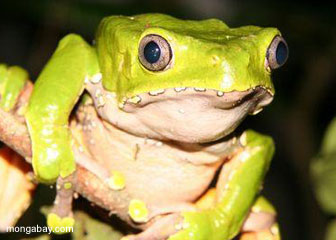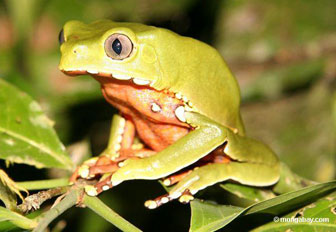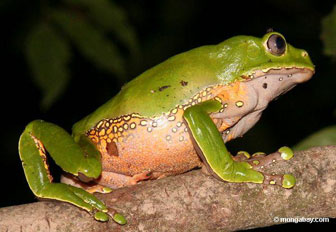Used for centuries as a natural disease prevention and physical stimulant, an Amazonian tree frog has become a symbol of Brazil’s fight to benefit the Indigenous from scientific developments based on their knowledge
There are more than one hundred frog species in the Amazon forest. For modern science, it would be unthinkable to start doing tests on people’s bodies to know the effects of these secretions on human health. But indigenous communities in Brazil show that living in the jungle for centuries makes things different.
“We don’t know when and why we started taking this frog’s vaccine”, says Fernando Katukina, the chief of the Katukina indigenous community formed by 500 members in the Brazilian Amazon. “It is part of our culture since we recognize ourselves as a people. As we have always had the arrow to hunt and the ceramic pot to cook and eat, we have had the frog as our medicine”, completes Chief Fernando.
The indigenous vaccination that Chief Fernando talks about is very different from modern medicine’s drops or injections. Kako Katukina, an indigenous doctor apprentice, lights a small wooden stick. He smokes the stick slowly while he explains that “the vaccine will cure any diseases you have and it will also bring good luck to your love life”. With the stick in flames, Doctor Kako burns “four points” on my leg and with a sharp knife he puts the frog’s poison on them.
The blood circulation rushes almost immediately. The intense pressure starts on the head and passes through the heart to all the extremities of the body. After two minutes of intense blood circulation, vomiting starts and lasts for about three minutes until the bile is expelled. The relief comes in the form of a cold sweat, a feeling of lightness and stamina.

Monkey frog in Peru. Photo by Rhett A. Butler |
“It is curious to think about why the Indigenous have chosen this frog. There are about 18 different species of phyllomedusas [the indigenous’ frog species] in the Amazon forest but the indigenous only use three of them to make the vaccine. If they had chosen other species, they could die by the much higher concentration of the poison found in these other similar frogs”, says Dr Leonardo Calderon, a Brazilian molecular biologist from the State University of Acre who has studied the frog’s poison used by the Katukina tribe.
Nowadays, there are about 20 patents on laboratory experiments made with the frog’s poison, but none of them were filed or developed in Brazil. These scientific developments based on the indigenous knowledge prove that living in the jungle is also a way to make science.
The Katukinas start taking the vaccine when they are only one-year-old as a form of protection against diseases. “Isolated molecules from phyllomedusas are highly anti-bacterial and can kill very resilient bacteria, like hospital bugs. It can also be used to cure sexual diseases and illnesses that are very common in poor and tropical countries like leishmaniose – a bacteria that destroys people’s tissues, cartilages and internal organs – and the chagas illness that is transmitted by a protozoa”, says Dr Calderon.
The anti-bacterial effect mentioned by Dr Calderon are caused by deltorphines, that have been studied to combat HIV too. Moreover, the secretion of tree frog used by the Indigenous has demorphines, a pain-killer that is 33 per cent more effective than morphine, and has been studied to treat brain-cancer and Alzheimer’s.
The other use mentioned by the Indigenous also has an explanation. The Katukinas say that the vaccine combats hunters’ laziness and bad luck. The amount of raw poison experienced by non-Indigenous are insignificant if compared to the Indigenous hunters. Guests take up to six points, but Katukina hunters can burn up to 120 points to apply the poison before going in the search of animals to feed their families. Science could explain the laziness-inhibitor effect as the poison has a stimulant effect that could be used against depression and cardio-vascular problems.
Even though scientists are very well known by indigenous tribes when they visit these remote areas in their search for plants or animals, the Katukinas only got to know that their knowledge was taken to international laboratories in 2003, 14 years after the first patent was requested in Japan. And with the realisation came the desire. “We want to work in partnership with a company to isolate one of the molecules from the frog’s poison and develop a medicine that is going to be patented in our name”, says Chief Fernando.
The poison of the tree frog is also used by about 10 other communities in the region of the Brazilian Amazon that the Katukinas live and many others in the Peruvian territory. Although the Katukinas are the most well known tribe that uses the frog’s poison in Brazil, it was from a tribe based on the border of Peru and Brazil that the Indigenous knowledge was sent to international laboratories.
In his trip as a tourist to the Amazon in 1983, the American journalist Peter Gorman visited a tribe called the Matsés, that is based on the border between Brazil and Peru. There, he took the frog’s vaccine. However, he did not only write about it, he also gave samples of the poison to the American Museum of Natural History and to the Fidia Research Institute for the Neurosciences in Rome. Six years later, patents started to be filed and international laboratories started to synthesize the frog’s molecules as the animal does not produce the poison in captivity.
Nowadays, 25 grams of demorphine can be bought for up to £750 ($1500) and deltorphines for up to £250 ($500) on technology-based companies specialized in biochemical and pharmaceutical compounds, like the Swiss Bachem. But what the buyers are doing with these substances is still unclear.
 Monkey frog in Peru (photo by Rhett A. Butler). Scientists are particularly concerned about the global decline of amphibians over the past 20 years. Recent research suggests that the amphibian crisis is tied to global warming. |
“I know there are people who are doing different things from what is already published, but they are quiet. It is going to take long, but there is a lot of money to be made” says Mr Gorman. The journalist says he believes the Matsés still do not know about the patents because “they are too remote to understand them”. But when the money comes, he will want his and the tribe’s share. “At some point, they will have to recognize where it started. And it started with me and the Matsés. I have the right to get some money from these companies and so do the Matsés”, he says.
On the Brazilian side, the government is the one who has been standing up for the Indigenous, but still no success has been reached. “It is difficult to follow the link between a patent and a product. It is hard to find out how much of the substances are present in a final product and how important they are in the whole composition. Our research’s results are too preliminary to say if the poison has become a product”, says Henrique Moraes, a Brazilian diplomat.
Mr Moraes is part of the Brazilian team of negotiators in the World Trade Organisation (WTO). Together with 10 other developing countries that are rich in biodiversity and traditional communities, Brazil wants the Trade Related Aspects of Property Rights (TRIPS) to mention that traditional communities have the right to benefit from scientific or commercial developments based on their knowledge.
Brazil’s proposal follows a United Nations convention, the Convention of Biological Diversity (CBD). According to the convention, created in 1992, natural resources are not a common good, but something that belongs to countries that hold these resources. In the same way, the CBD says that traditional communities have the right over their knowledge and can ask to be benefited from any scientific or commercial development based on them.
Brazil’s proposal is contested in the WTO by the US, that says that no amendment is needed on TRIPS because community rights can be guaranteed by private contracts between the Indigenous and institutions interested in working with their knowledge and resources. The EU has not submitted any formal document on the WTO, but via World Intellectual Property Organisation (WIPO), it contests the point of Brazil’s proposal that asks patents to be cancelled when not in accordance with the principles of previous consent and benefit sharing.
“These communities should already be receiving technology transfer from these developments. But this is very difficult because we have never found any patent that mentions their existence and where the resources came from. If our proposal comes true, patent filings will have to mention where the resources used came from and if there was any traditional knowledge involved. And the government also wants to be a negotiator between communities and companies, because their power of bargaining cannot be considered equal”, says Mr Moraes.

Monkey frog in Peru. Photos by Rhett A. Butler |
But before being able to put his agenda on the WTO, Brazil has tried to implement the proposal nationally, and things do not seem to be any better. The Katukinas were only informed about the international patents after they had a problem in Brazil. Some of its members started to apply the vaccine outside the tribe. Non-Indigenous quickly realised the commercial potential of the natural and ‘cool medicine’. The frog vaccine hit the alternative clinics of Brazil’s capitals with advertisements that mentioned the cure of up to 30 diseases with the raw poison applied in the Indigenous way. “We wrote a letter to the government because we wanted to stop all this ‘bio-piracy’. The knowledge was ours, but it has been spread all over without our consent”, remembers Chief Fernando.
After the Indigenous asked for help, the Brazilian Environment Ministry created a special project for the frog’s vaccine. They have gathered three of the tribes that use the vaccine in Brazil and have trained them to negotiate the development of a product based on the frog’s poison with private companies. But the experience showed that business and traditional knowledge are not an easy combination. “The company interested doesn’t even want its name to be published because it says it is very risky for its image if the project fails and doesn’t meet the Indigenous’ expectations”, says Bruno Filizola, the director of the Brazilian Project for Bio-prospecting (Probem).
The project also had a scientific base. “It is a project that has never existed given the lack of resources and too much bureaucracy”, says Paulo Bernarde, a herpetologist from the State University of Acre (Ufac) who lives in the region where the indigenous tribes are based.
Dr Bernarde was invited by the government to study the effects on the frog’s breeding and ecology after the collection of the poison for the vaccine, but he gave up after having to face the regulatory agencies in Brazil. “The Brazilian government should think better about what it is to access the traditional knowledge when dealing with cases that don’t aim to make profits. Everything has already been published without the indigenous consent. Now we want to work with them, but Brazil has adopted a national policy that jeopardizes scientific studies that could collect information for bio-prospecting and allow us to compete with the foreign bio-pirates”, he says.
Another part of the project is a spectrometry laboratory to analyse the secretions from frogs in the Amazon with the participation of indigenous communities. “There is a huge potential to be explored. Novelties that haven’t been explored abroad can be found. Within the Amazon region, we can look for endogamy populations that only breed between themselves that can have particular mutations.”, says Dr Calderon. But this project has not started either. “It would involve many indigenous communities, but now they are afraid of the changes that this participation would bring to their societies and they need time to think about it”, he says.
Scientists complain, foreigners ask for their share and the Brazilian government struggles. But even being aware of all the impediments, Chief Fernando keeps positive and patient. “We know it will take time and we are ready to share the benefits with all the communities that didn’t get involved with the negotiations. When the benefits come, we will invest in health and education to keep ourselves and our culture strong”, he says. Science may not know, but the frog might also bring a serenity that would sell millions in the modern world.
Carolina Bruun
Carolina Bruun is London-based Brazilian working on a masters degree in International Journalism at City University in the UK. She spent two months in Acre, Brazil developing this and other articles.














